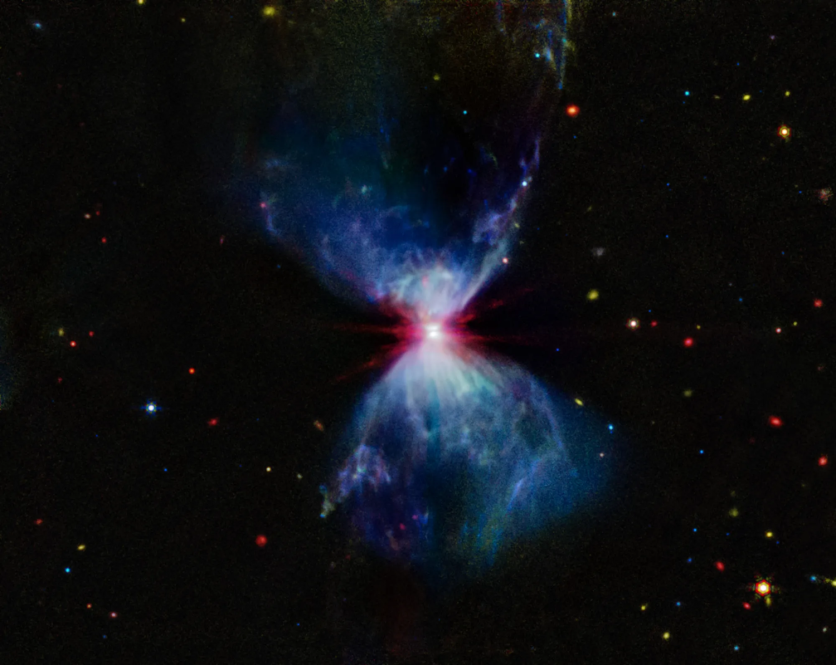NASA's James Webb Space Telescope has captured an explosive and festive scene resembling cosmic fireworks in the constellation Taurus. This new image, obtained with Webb's Mid-Infrared Instrument (MIRI), showcases a bright hourglass-shaped nebula surrounding a youthful protostar in its early stages of stellar evolution.

NASA's James Webb Space Telescope Captures Cosmic Fireworks on an Hourglass-Shaped Dust Clouds
Located approximately 460 light-years away, L1527 is embedded within a molecular cloud, a type of nebula. The central protostar is actively accreting material from a protoplanetary disk, visible as a dark band along its equator.
Molecular clouds, which are interstellar clouds of gas and dust in which molecules, mainly hydrogen, can form, play a crucial role in star formation.
According to NASA, the imagery from MIRI highlights distinct features: diffuse blue hues and filamentary structures are attributed to polycyclic aromatic hydrocarbons (PAHs), while a vibrant red glow emanates from an energized layer of gases and dust enveloping the protostar.
The intermediate zones, depicted in white, consist of a mixture of PAHs, ionized gas, and other molecular components. Specifically, the image employs filters that render 7.7 microns light as blue, 12.8 microns light as green, and 18 microns light as red, providing a detailed spectrum of this cosmic spectacle.
The protostar at the heart of L1527 is estimated to be around 100,000 years old and remains embedded within its parent molecular cloud, which is a vast reservoir of gas and dust. Webb's earlier observations with the Near-Infrared Camera (NIRCam) revealed L1527's molecular cloud in vivid, opaque colors, complementing the current MIRI view.
The NIRCam and MIRI observations illustrate the impacts of outflows and jets of material ejected along the protostar's axis of rotation. NASA explained that these outflows interact with the surrounding molecular cloud, creating bow shocks appearing as filamentary structures and sculpting the observed hourglass structure.
NASA further noted that the energized outflows excite the surrounding matter, causing it to glow and producing an effect reminiscent of fireworks against a celestial backdrop.
A Star in Red, Blue, and White
The predominant blue hues in the hourglass structure correspond to carbonaceous molecules like PAHs, indicative of the complex chemistry occurring within the cloud. On the other hand, the red regions signify the protostar itself and its surrounding envelope of dense dust and gases.
Additionally, the white regions above and below the protostar, less prominent in NIRCam images, reveal a blend of hydrocarbons, ionized neon, and thick dust particles, underscoring the protostar's influence as it disperses matter from its immediate vicinity.
NASA added that as the protostar evolves, its energetic jets will continue to disrupt the molecular cloud, gradually erasing the intricate structures captured in the current image. Ultimately, as the protostar completes its formation and stabilizes, these displays will fade, revealing a mature star visible even to optical telescopes.
The combined insights from both near-infrared and mid-infrared observations provide a comprehensive understanding of L1527's dynamics, illustrating how the central protostar shapes its surroundings.
According to NASA, similar processes are unfolding in neighboring star-forming regions within Taurus, potentially influencing the fate of molecular clouds and the birth of future stars in the cosmos.
Related Article : NASA's James Webb Space Telescope Will Look for Signs of Life in New 7 Earth-sized Planets Around TRAPPIST-1

![Apple Watch Series 10 [GPS 42mm]](https://d.techtimes.com/en/full/453899/apple-watch-series-10-gps-42mm.jpg?w=184&h=103&f=9fb3c2ea2db928c663d1d2eadbcb3e52)



